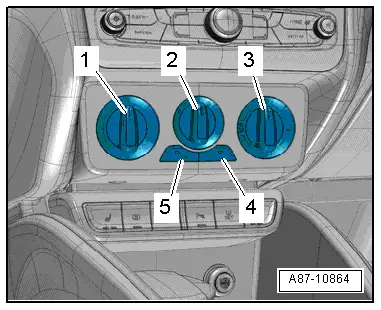| Checking heat output - vehicles with manually controlled air conditioner |
| Special tools and workshop equipment required |
| t
| Vehicle diagnostic tester |
| t
| Commercially available thermometer (for temperature measurement; if applicable use thermometer with 2 probes for simultaneous measurement of temperature e.g. on right and left) |
| l
| All air ducts, covers and seals OK and properly installed |
| l
| Vehicle not exposed to sunlight |
| l
| Event recorder of operating unit, air conditioning system control unit -J301- interrogated and erased, basic setting performed in
„Guided fault-finding“ function → Vehicle diagnostic tester |
| –
| Close the front lid, doors, windows and sun roof. |
| –
| Open all dash panel vents. |
|
|
|
 Note
Note
 Note
Note